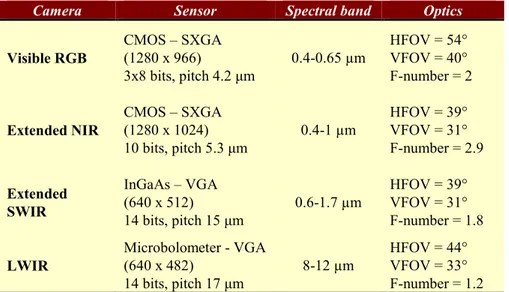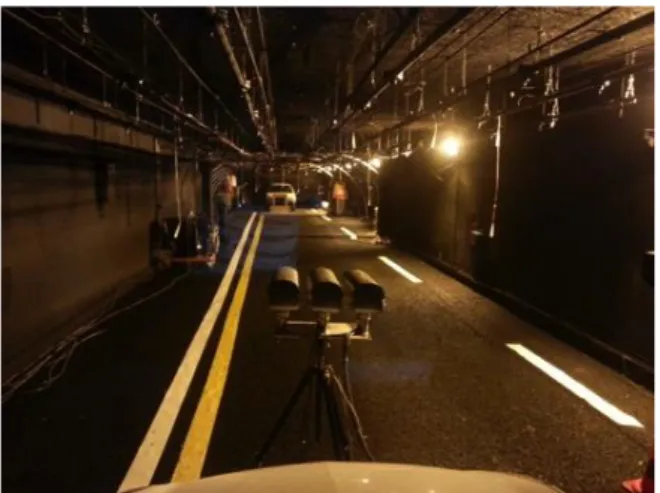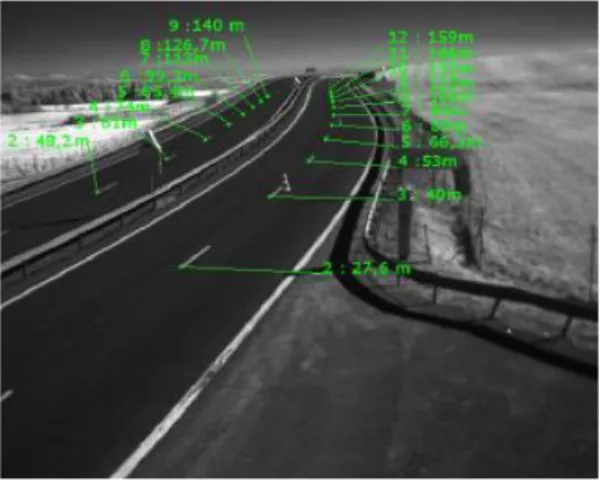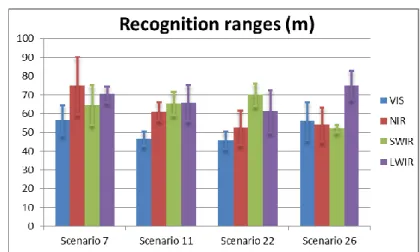HAL Id: hal-01975285
https://hal.archives-ouvertes.fr/hal-01975285
Submitted on 9 Jan 2019
HAL is a multi-disciplinary open access
archive for the deposit and dissemination of
sci-entific research documents, whether they are
pub-lished or not. The documents may come from
teaching and research institutions in France or
abroad, or from public or private research centers.
L’archive ouverte pluridisciplinaire HAL, est
destinée au dépôt et à la diffusion de documents
scientifiques de niveau recherche, publiés ou non,
émanant des établissements d’enseignement et de
recherche français ou étrangers, des laboratoires
publics ou privés.
All-weather vision for automotive safety: which spectral
band?
Nicolas Pinchon, Olivier Cassignol, Frédéric Bernardin, Adrien Nicolas,
Patrick Leduc, Jean Philippe Tarel, Roland Bremond, Emmanuel Bercier,
Johann Brunet
To cite this version:
Nicolas Pinchon, Olivier Cassignol, Frédéric Bernardin, Adrien Nicolas, Patrick Leduc, et al..
All-weather vision for automotive safety: which spectral band?. AMAA 2018, Advanced Microsystems
for Automotive Applications, Sep 2018, Berlin, Germany. pp. 3-15, �10.1007/978-3-319-99762-9_1�.
�hal-01975285�
All-weather vision for automotive safety:
which spectral band?
N. Pinchon1, O. Cassignol2, A. Nicolas2, F. Bernardin3, P. Leduc4, J-P.
Tarel5, R. Brémond5, E. Bercier6, J. Brunet7 1: VALEO, 34 rue Saint André 93012 Bobigny Cedex, France
2: SAFRAN E&D, 21 Avenue du Gros chêne 95610 Éragny Sur Oise, France 3: CEREMA, 8-10 rue Bernard Palissy 63017 Clermont-Ferrand Cedex 2, France 4: CEA / Léti - 17 rue des Martyrs - 38054 Grenoble cedex 9, France
5: Université Paris-Est, IFSTTAR, 14-20 Boulevard Newton, 77420 Champs-sur-Marne, France
6: ULIS, 364 Route de Valence, Actipole – CS 10027 - 38113 Veurey-Voroize, France 7: NEXYAD, 95 Rue Pereire 78100 Saint-Germain-en-Laye, France
Abstract
The AWARE (All Weather All Roads Enhanced vision) French public funded project is aiming at the development of a low cost sensor fitting to automotive and aviation requirements, and enabling a vision in all poor visibility conditions, such as night, fog, rain and snow.
In order to identify the technologies providing the best all-weather vision, we evaluated the relevance of four different spectral bands: Visible RGB, Near-Infrared (NIR), Short-Wave Near-Infrared (SWIR) and Long-Wave Near-Infrared (LWIR). Two test campaigns have been realized in outdoor natural conditions and in artifi-cial fog tunnel, with four cameras recording simultaneously.
This paper presents the detailed results of this comparative study, focusing on pedestrians, vehicles, traffic signs and lanes detection.
1
Introduction
In the automotive industry, New Car Assessment Programs (NCAP) are increas-ingly pushing car manufacturers to improve performances of Advanced Driver Assistance Systems (ADAS), and especially autonomous emergency braking on vulnerable road users (VRU). For instance the 2018 Euro NCAP roadmap is mov-ing towards pedestrians and pedal cyclists detection in day and night conditions. This trend matches accidentology figures, like those provided by French Road Safety Observatory (Table 1).
Injury casualties Fatalities
Night 32% 41%
Wet road 20% 20%
Adverse weather 21% 23%
Table 1. 2014 French accidentology data in adverse conditions [1]
In the longer term, after automated parking and highway driving, all weather and city driving will be the main technical challenge in the automated driving roadmap.
Current ADAS sensors as visible cameras or Lidars are fitting functional require-ments of VRU and obstacle detection in normal conditions (day or night). Howev-er, these technologies show limited performances in adverse weather conditions such as fog or rain.
Automotive industry is thus facing this new challenge of detecting vehicle envi-ronment in all conditions, and especially in poor visibility conditions, such as night, fog, rain and snow.
This topic has been addressed in the framework of the AWARE French public funded project, aiming at the development of a sensor enabling a vision in all poor visibility conditions. This paper presents an experimental comparative study of four different spectral bands: Visible RGB, Near-Infrared (NIR), Short-Wave In-frared (SWIR) and Long-Wave InIn-frared (LWIR). Sensors and field tests are de-scribed in section 2 and 3. Experimental results are detailed in section 4, focusing on pedestrians, vehicles, traffic signs and lanes detection.
2
Sensors
In this project, we only focus on cameras technologies, and not on distance meas-urement systems like LIDARs or RADARs. But it is well-known that both tech-nologies are complementary and necessary to bring redundancy for improving the detection system’s reliability and accuracy [2].
Four cameras were tested during the project. The Table 2 shows their characteris-tics.
The visible RGB CMOS camera is used here as a reference for the test.
Extended NIR camera uses monochrome CMOS photodiodes with a cut-off wave-length close to 1 µm. It detects the reflective visible and NIR light from the scene. It thus requires an illumination by sun, moon or night glow or an illuminator posi-tioned on the vehicle.
Camera Sensor Spectral band Optics Visible RGB CMOS – SXGA (1280 x 966) 3x8 bits, pitch 4.2 μm 0.4-0.65 µm HFOV = 54° VFOV = 40° F-number = 2 Extended NIR CMOS – SXGA (1280 x 1024) 10 bits, pitch 5.3 μm 0.4-1 µm HFOV = 39° VFOV = 31° F-number = 2.9 Extended SWIR InGaAs – VGA (640 x 512) 14 bits, pitch 15 μm 0.6-1.7 µm HFOV = 39° VFOV = 31° F-number = 1.8 LWIR Microbolometer - VGA (640 x 482) 14 bits, pitch 17 μm 8-12 µm HFOV = 44° VFOV = 33° F-number = 1.2
Table 2. Cameras characteristics
Extended SWIR camera is based on InGaAs III-V material and extends from a wavelength of 0.6 µm, red to human eye, to 1.7 µm in the SWIR infrared band. SWIR spectral band is typically used for active (reflective) vision in very dark condition with a good contrast as SWIR light is generally more reflective than vis-ible light.
LWIR sensor is an array of microbolometers. It detects the thermal radiation in the spectral band extending from 8 µm to 14 µm. Any object emits radiations which depend on its temperature. For a human or an animal at ambient temperature, the maximum of emission corresponds to a wavelength close to 10µm. LWIR is used for the detection of a temperature contrast and do not require an illuminator. Mid-Wave Infrared (MWIR) has not been added in the study for reasons of cost and compacity, due to the cooling system required for the detectors.
3
Field tests
3.1 Outdoor test campaign
The four cameras were installed during one month in 2015 along the French mo-torway A75/E11 at the site named La Fageole. A weather station located near the cameras was equipped with a diffusiometer (meteorological visibility), a rain
gauge, a luxmeter (ambient light) and a temperature and humidity sensor (ambient air).
Fig. 1. Outdoor test campaign
More than 33 different scenarios have been set depending on weather conditions (rain type and intensity, ambient temperature), ambient light, and human eye visi-bility distance. Table 3 shows the most interesting recorded scenarios, with a class 3 fog (visibility distance < 100 m):
Scenario Weather Visibility distance Ambient light Tempe-rature 7 Day, heavy fog, light snow 75 m 5032 lux -1°C
11 Day, heavy fog and snow 69 m 1096 lux -1°C
22 Day low light, heavy fog and snow 75 m 104 lux -0.8°C
26 Night, heavy fog 99 m 0 lux +1.5°C
Table 3. Most interesting recorded outdoor scenarios
3.2 Tunnel test campaign
The tests were carried in the CEREMA fog tunnel in Clermont-Ferrand (30m length, 5.5m width and 2.5m height). Artificial fog and rain are reproduced and controlled: fog and rain drop size, meteorological visibility of fog and rain intensi-ty. Two fog classes are available: unimodal drop size distribution (DSP) centred around 1 micron and bimodal DSP centred around 1.5 and 10 microns. 74 scenari-os were performed by varying the type of adverse weather conditions (fog and rain), scene illumination (night, day, automotive lighting, aircraft lighting) and
glare (front vehicle). The scene in front of the cameras contained road pavement, road marking, pedestrians and lights (see Fig. 2).
Fig. 2. CEREMA fog tunnel
4
Field tests
In this section, we describe the detection and recognition range performances that were measured in this study. It is important to keep in mind that these results re-flect not only the intrinsic characteristics of the spectral bands but also the capabil-ity of the chosen cameras. The cameras were selected to be representative of the typical current state-of-the-art.
In order to prevent any detection algorithm artefact, a visual analysis has been per-formed by two different human observers. As expected, exact detection range val-ues differed from one observer to the other, but the relative valval-ues were consistent. In all cases, brightness and contrast were carefully tuned in order to optimize ranges.
With respect of each camera’s channels created by the four spectral bands, a video database has been created to remotely record videos of relevant scenes for each listed scenario. The Fig. 3 provides a sample of the video database (outdoor cam-paign):
Fig. 3. Example of snapshots recorded by LWIR (top left), Visible (top right), SWIR (bottom
left) and NIR (bottom right) cameras
4.1 Pedestrian detection
Pedestrian detection tests have been performed into Cerema fog tunnel using real human bodies, as illustrated in the Fig. 4.
Fig. 4. Pedestrian detection test setup into Cerema fog tunnel, LWIR (top left), Visible (top
right), SWIR (bottom left) and NIR (bottom right) cameras
Objects moving in the fog generate important transmission inhomogeneities. In order to avoid errors due to this effect, we recorded films of human test subjects
standing still at the end of the tunnel while the fog cleared over time. Detection was declared successful when the outline of the chest of the test subject became visible against the background. This way, detection ranges were measured at the height at which the transmission meter was set. The test subjects were ~ 25 m away from the cameras. One of the test subjects wore a high visibility jacket and another one wore dark clothes. As expected, Visible, NIR and SWIR detection performances were better for the subject wearing the high visibility jacket (even though this improvement is less pronounced for thicker fog). For this study, the case of the subject in dark clothes was deemed more relevant.
The following table gives the fog density, expressed as standard visibility ranges, at which the pedestrian becomes visible. A reduced visibility range indicates a successful pedestrian detection in a thicker fog, and hence a better capability to see through fog. Cases with glare are not included.
Camera Fog density for pedestrian detection
Visible RGB Moderate (visibility range = 47 ± 10 m) Extended NIR High (visibility range = 28 ± 7 m) Extended SWIR High (visibility range = 25 ± 3 m) LWIR Extreme (visibility range = 15 ± 4 m)
Table 4. Fog thickness for pedestrian detection at 25 m with the different cameras
Error ranges mostly reflect the dispersion between the different scenarios used in the study.
Conclusions are the following:
► The LWIR camera has a better capability to see through fog than the NIR and SWIR ones. The visible camera has the lowest fog piercing capability. ► The LWIR camera is the only one that allows pedestrian detection in full
darkness.
► The LWIR camera also proved more resilient to glare caused by facing head-lamps in the fog. Other cameras sometimes missed a pedestrian because she or he was hidden by the glare.
Fig. 5. Example of images recorded in the fog tunnel with the four different cameras
4.2 Vehicle detection and recognition
Vehicle detection ranges were measured in the outdoor test campaign.
Similarly to military range performance tests, we define two tasks of interest: de-tection and recognition. Dede-tection means the presence of an object on the road can been acknowledged, even if the type of object cannot be assessed. Recognition means that the detected object can be classified into a category such as: truck, car, motorcycle, bicycle, pedestrian, animal, static obstacle… In particular, VRU can be distinguished from other vehicles. The Fig. 6 illustrates detection and recogni-tion in two different spectral bands (images are from different scenarios).
Detection
Recognition
Task VIS LWIR
Distances were calibrated within the cameras’ field of view using the road markings (which are clearly visible for all cameras in images recorded on a sunny day) and an aerial map of the area. That method gives a distance measurement precision on the order of a few meters simply by noting the vehicle position within an image. The maximal distance that could be reliably assessed by this method was on the order of 150 m.
Fig. 7. Reference of range based on site map analysis and T1 lanes type of road marking
Average detection and recognition ranges are given in the Fig. 8 and Fig. 9 for the different spectral bands and for each of the four scenarios of interest. A total of 22 vehicles were observed. Error bars give the dispersion between the different vehi-cles observed within a given scenario.
Fig. 9. Vehicle recognition ranges (except cases with vehicle hidden by glare)
In VIS, NIR or SWIR, detection was performed using the vehicle headlamps. The case of a vehicle driving with headlamps off while in adverse conditions was not encountered in this study. Should it happen, however, detection ranges in VIS, NIR and SWIR would be on the order of the recognition ranges. In LWIR, detec-tion relied on the observadetec-tion of hot vehicle parts: the wheels, the motor or the ex-haust system.
In some foggy instances, recognition proved difficult or even impossible in VIS, NIR or SWIR because the vehicle remained entirely hidden by the glare of its own headlamps. When this happened, the vehicles were not taken into account in the average ranges given in Fig. 9. Images illustrating this phenomenon are given in the Fig. 10. SWIR here presents more glare than the other bands but it is only due to the camera settings, it is not an intrinsic characteristic of the spectral band.
VIS NIR SWIR LWIR
Fig. 10. Images showing the glare effect in the VIS, NIR and SWIR spectral bands
The visual observation of the videos also confirmed the well-known fact that the exploitation of movement by the human visual system greatly increases detection capabilities: the success of the detection task is much higher when performed while watching a film than when performed by observing still images taken from the very same film. This is due to the human visual cortex implementing advanced spatiotemporal denoising and should inspire detection software developers. In some recordings, wild animals are visible on the side of the road in the LWIR band. These animals are visible in none of the other spectral bands.
The conclusions are the following:
► For vehicles with headlights on, detection in adverse conditions is better in SWIR. NIR comes next and then VIS and LWIR.
► For the recognition task in the same conditions, the conclusions are inverted. ► The VIS, NIR and SWIR bands are sensitive to glare in foggy conditions,
making the recognition task impossible in many cases.
► For both tasks, the LWIR camera gives much more reproducible results than all the others. In particular, its performance is independent of the vehicle’s headlights being on or off.
► The LWIR camera was also the only one allowing the detection of hot blood-ed animals on the side of the road in adverse conditions.
4.3 Road marking detection
Detection ranges of road markings were evaluated in the outdoor test campaign by using the road lines of the highway. The same calibration as for vehicle detection was used to measure the distances.
The Table 5 gives the average maximal detection distance for the four scenarios of interest: Sce-nario Visibility [m] Ambient light [Lux]
Maximal detection range [m] VIS NIR SWIR LWIR 7 75 5032 53 63 66 -
77 69 1096 50 60 63 -
22 75 104 53 60 63 -
26 99 0 53 53 53 -
Table 5. Road lines detection ranges
Conclusions are the following:
► Observation in the LWIR spectral band is only depending on road marking thermal emissivity. In 15 of the 21 scenarios recorded in LWIR, road mark-ings are not visible. The visibility depends on the weather: rain is cleaning the lines while sun exposure enhances them (see Fig. 11). Thus road marking ob-servation in the LWIR spectral band is not relevant.
► Visible, NIR and SWIR all required additional lighting to detect road marking at night. Detection in NIR and SWIR are equivalent, and slightly better than VIS. This is due in part to: a broader overall spectral band, monochromaticity (no RGB filter), larger pixels and a higher bit depth.
Fig. 11. Road marking observation in the LWIR spectral band during day sunny condition
(left) and day rainy condition (right)
4.4 Traffic signs recognition
The traffic sign located at 38 m from the cameras on La Fageole test site has been used to realize the comparative study. The Figure 12 shows the sign in two differ-ent weather conditions.
Conclusions of the analysis of all the scenarios are the following:
► The SWIR sensor does not allow the identification of the traffic sign, even during daylight. This is due to the fact that the difference of reflectivity be-tween the letters and the background is very low in the SWIR band. Traffic signs are indeed designed for visible spectrum and not for the other bands. ► The NIR camera provides a good vision and a better SNR than the RGB
visi-ble camera, especially in adverse weather conditions. This is due to the same reasons as for road markings detection.
► As expected, the traffic sign is never identifiable in the LWIR band. Letters and background have indeed the same temperature and emissivity.
VIS NIR SWIR
Fig. 12. Images of traffic sign acquired in different spectral bands. In the first line, weather
conditions is a sunny day and in the second line is from scenario 7 (fog class 3 with snow)
5
Conclusion
As they are complementary to other distance measurement systems like LIDARs or RADARs, the AWARE project only focused its experiments on cameras tech-nologies that are necessary to bring redundancy and complementary characteris-tics for improving ADAS detection system’s reliability and accuracy.
In order to detect pedestrian, vehicle, road marking or recognize traffic signs, the relevance of four different spectral bands has been evaluated under adverse weather conditions: Visible RGB, Near-Infrared (NIR), Short-Wave Infrared (SWIR) and Long-Wave Infrared (LWIR).
The Table 6 and Table 7 summarize the relative performances of ADAS function for the four different cameras.
ADAS FUNCTION
Camera Spectral band Night Fog, using headlights
VIS NIR SWIR LWIR
Pedestrian, Bicycles, Animals detection + ++ ++ ++++ Vehicle shape recognition - - -- ++ Vehicle lights detection + ++ +++ -- Traffic signs recognition + ++ - -- Road marking detection + ++ ++ -
Table 6. Comparison of performances of ADAS functions using Visible, NIR, SWIR or LWIR
camera technologies, Night fog, headlights
ADAS FUNCTION
Camera Spectral band Day Fog, using headlights
VIS NIR SWIR LWIR
Pedestrian, Bicycles, Animals detection + ++ ++ ++++ Vehicle shape recognition + ++ ++ ++ Traffic signs recognition + ++ - -- Road marking detection + ++ ++ -
Table 7. Comparison of performances of ADAS functions using Visible, NIR, SWIR or LWIR
camera technologies, Day fog, headlights Results of experiments clearly state that:
► In addition to the visible spectral band, only the LWIR spectral band provides outstanding interests. Targets can be detected with or without additional light. LWIR detection is not sensitive to any dazzle.
► NIR and SWIR provide equivalent performances, mainly due to the fact that experiments used extended visible to NIR and visible to SWIR cameras. How-ever, as scattering in fog is reduced when wavelength increases, a NIR-only or a SWIR-only camera would certainly have provided much better performances than extended spectral bands.
► Visible RGB extended to NIR (or Red-Clear sensors) combined with LWIR provide the best spectral bands combination to improve ADAS performances of detection such as vehicle, pedestrian, bicycle, animals or road marking, and recognition such as traffic signs.
► Caution shall be considered while using LED headlight technology to provide additional light. LED pulsed technology could reduce detection reliability of system based on Visible, NIR and SWIR cameras.
5
Acknowledgement
The authors acknowledge the contribution of their colleagues to this work: P. Morange, J-L. Bicard and all the pedestrians from CEREMA, A. Picard from Sagem and B. Yahiaoui from Nexyad.
6
References
[1] French Road Safety Observatory (ONISR): "Les accidents corporels de la circulation 2014 – Recueil de données brutes", May 2015.
[2] C. Premebida, O. Ludwig, and U. Nunes: “Lidar and vision-based pedes-trian detection system,” Journal of Field Robotics, vol. 26, no. 9, pp. 696–711, 2009
7
Glossary
ADAS: Advanced Driver Assistance Systems AWARE: All Weather All Roads Enhanced vision CMOS: Complementary Metal Oxide Semiconductor LIDAR: LIght Detection And Ranging
LWIR: Long-Wave InfraRed
NCAP: New Car Assessment Programs NIR: Near InfraRed
RGB: Red-Green-Blue SNR: Signal-to-Noise Ratio SWIR: Short-Wave InfraRed VRU: Vulnerable Road User
8
Full Authors’ Information
Nicolas Pinchon
VALEO Comfort and Driving Assistance 34 rue Saint André
93012 Bobigny France
E-mail: nicolas.pinchon@valeo.com Olivier Cassignol
SAFRAN Electronics & Defense 21 Avenue du Gros chêne 95610 Éragny Sur Oise France
E-mail: olivier.cassignol@safrangroup.com Adrien Nicolas
SAFRAN Electronics & Defense 21 Avenue du Gros chêne 95610 Éragny Sur Oise France
E-mail: adrien.nicolas@safrangroup.com Frédéric Bernardin
CEREMA
8-10 rue Bernard Palissy
63017 Clermont-Ferrand Cedex 2 France
E-mail: frederic.bernardin@cerema.fr Patrick Leduc
CEA / Léti 17 rue des Martyrs 38054 Grenoble cedex 9 France
Jean-Philippe Tarel
University Paris-Est, IFSTTAR, Cosys/Lepsis 14-20 Boulevard Newton
77420 Champs-sur-Marne France
E-mail: Jean-Philippe.Tarel@ifsttar.fr Roland Brémond
University Paris-Est, IFSTTAR, Cosys/Lepsis 14-20 Boulevard Newton 77420 Champs-sur-Marne France E-mail: Roland.Bremond@ifsttar.fr Emmanuel Bercier ULIS 364 Route de Valence Actipole – CS 10027 38113 Veurey-Voroize France E-mail: e.bercier@ulis-ir.com Johann Brunet NEXYAD 95 Rue Pereire 78100 Saint-Germain-en-Laye France E-mail: jbrunet@nexyad.net
![Table 1. 2014 French accidentology data in adverse conditions [1]](https://thumb-eu.123doks.com/thumbv2/123doknet/12678246.354219/3.892.229.652.228.307/table-french-accidentology-data-in-adverse-conditions.webp)








